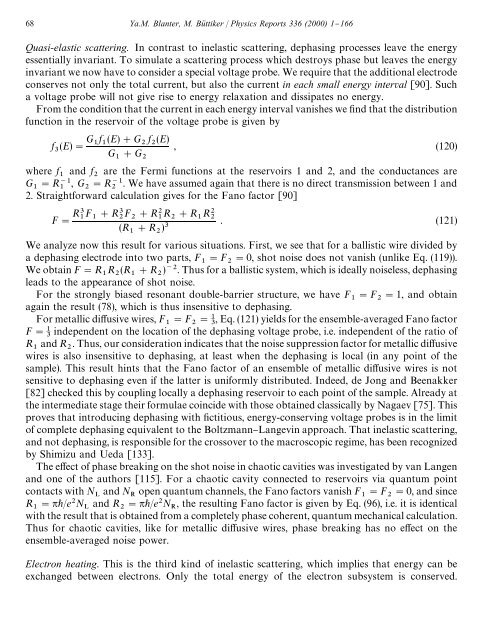shot noise in mesoscopic conductors - Low Temperature Laboratory
shot noise in mesoscopic conductors - Low Temperature Laboratory
shot noise in mesoscopic conductors - Low Temperature Laboratory
Create successful ePaper yourself
Turn your PDF publications into a flip-book with our unique Google optimized e-Paper software.
68 Ya.M. Blanter, M. Bu( ttiker / Physics Reports 336 (2000) 1}166<br />
Quasi-elastic scatter<strong>in</strong>g. In contrast to <strong>in</strong>elastic scatter<strong>in</strong>g, dephas<strong>in</strong>g processes leave the energy<br />
essentially <strong>in</strong>variant. To simulate a scatter<strong>in</strong>g process which destroys phase but leaves the energy<br />
<strong>in</strong>variant we now have to consider a special voltage probe. We require that the additional electrode<br />
conserves not only the total current, but also the current <strong>in</strong> each small energy <strong>in</strong>terval [90]. Such<br />
a voltage probe will not give rise to energy relaxation and dissipates no energy.<br />
From the condition that the current <strong>in</strong> each energy <strong>in</strong>terval vanishes we "nd that the distribution<br />
function <strong>in</strong> the reservoir of the voltage probe is given by<br />
f (E)"<br />
G f (E)#G f (E)<br />
, (120)<br />
G #G<br />
<br />
where f and f are the Fermi functions at the reservoirs 1 and 2, and the conductances are<br />
<br />
G "R<br />
, G "R.<br />
We have assumed aga<strong>in</strong> that there is no direct transmission between 1 and<br />
<br />
2. Straightforward calculation gives for the Fano factor [90]<br />
F" R F #R F #R R #R R . (121)<br />
(R #R )<br />
<br />
We analyze now this result for various situations. First, we see that for a ballistic wire divided by<br />
a dephas<strong>in</strong>g electrode <strong>in</strong>to two parts, F "F "0, <strong>shot</strong> <strong>noise</strong> does not vanish (unlike Eq. (119)).<br />
<br />
We obta<strong>in</strong> F"R R (R #R ). Thus for a ballistic system, which is ideally <strong>noise</strong>less, dephas<strong>in</strong>g<br />
<br />
leads to the appearance of <strong>shot</strong> <strong>noise</strong>.<br />
For the strongly biased resonant double-barrier structure, we have F "F "1, and obta<strong>in</strong><br />
<br />
aga<strong>in</strong> the result (78), which is thus <strong>in</strong>sensitive to dephas<strong>in</strong>g.<br />
For metallic di!usive wires, F "F ", Eq. (121) yields for the ensemble-averaged Fano factor<br />
<br />
F" <strong>in</strong>dependent on the location of the dephas<strong>in</strong>g voltage probe, i.e. <strong>in</strong>dependent of the ratio of<br />
<br />
R and R . Thus, our consideration <strong>in</strong>dicates that the <strong>noise</strong> suppression factor for metallic di!usive<br />
<br />
wires is also <strong>in</strong>sensitive to dephas<strong>in</strong>g, at least when the dephas<strong>in</strong>g is local (<strong>in</strong> any po<strong>in</strong>t of the<br />
sample). This result h<strong>in</strong>ts that the Fano factor of an ensemble of metallic di!usive wires is not<br />
sensitive to dephas<strong>in</strong>g even if the latter is uniformly distributed. Indeed, de Jong and Beenakker<br />
[82] checked this by coupl<strong>in</strong>g locally a dephas<strong>in</strong>g reservoir to each po<strong>in</strong>t of the sample. Already at<br />
the <strong>in</strong>termediate stage their formulae co<strong>in</strong>cide with those obta<strong>in</strong>ed classically by Nagaev [75]. This<br />
proves that <strong>in</strong>troduc<strong>in</strong>g dephas<strong>in</strong>g with "ctitious, energy-conserv<strong>in</strong>g voltage probes is <strong>in</strong> the limit<br />
of complete dephas<strong>in</strong>g equivalent to the Boltzmann}Langev<strong>in</strong> approach. That <strong>in</strong>elastic scatter<strong>in</strong>g,<br />
and not dephas<strong>in</strong>g, is responsible for the crossover to the macroscopic regime, has been recognized<br />
by Shimizu and Ueda [133].<br />
The e!ect of phase break<strong>in</strong>g on the <strong>shot</strong> <strong>noise</strong> <strong>in</strong> chaotic cavities was <strong>in</strong>vestigated by van Langen<br />
and one of the authors [115]. For a chaotic cavity connected to reservoirs via quantum po<strong>in</strong>t<br />
contacts with N and N open quantum channels, the Fano factors vanish F "F "0, and s<strong>in</strong>ce<br />
<br />
R "/eN and R "/eN , the result<strong>in</strong>g Fano factor is given by Eq. (96), i.e. it is identical<br />
<br />
with the result that is obta<strong>in</strong>ed from a completely phase coherent, quantum mechanical calculation.<br />
Thus for chaotic cavities, like for metallic di!usive wires, phase break<strong>in</strong>g has no e!ect on the<br />
ensemble-averaged <strong>noise</strong> power.<br />
Electron heat<strong>in</strong>g. This is the third k<strong>in</strong>d of <strong>in</strong>elastic scatter<strong>in</strong>g, which implies that energy can be<br />
exchanged between electrons. Only the total energy of the electron subsystem is conserved.
















